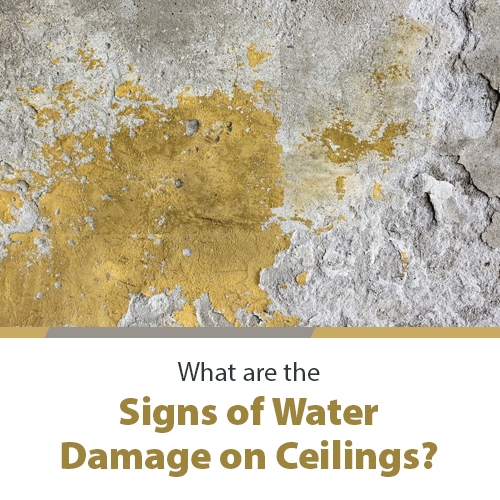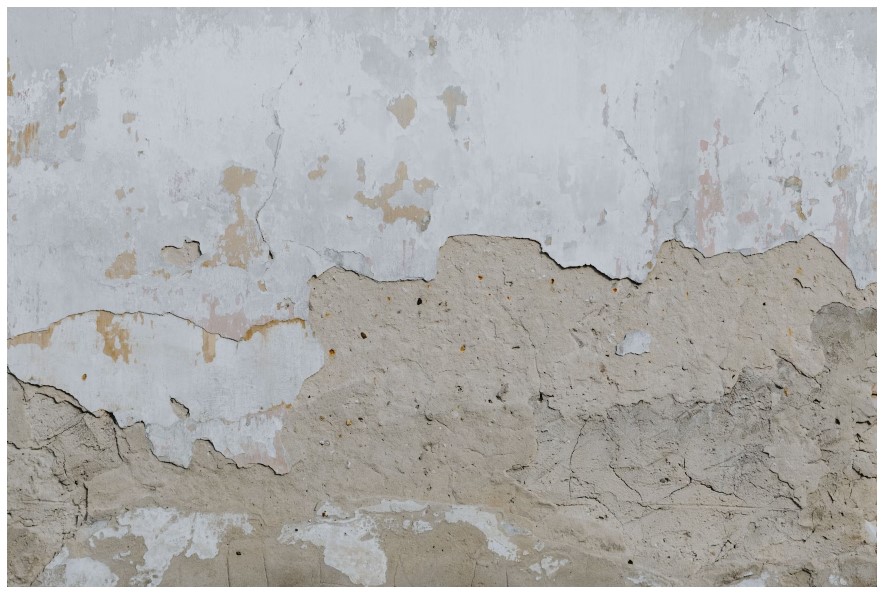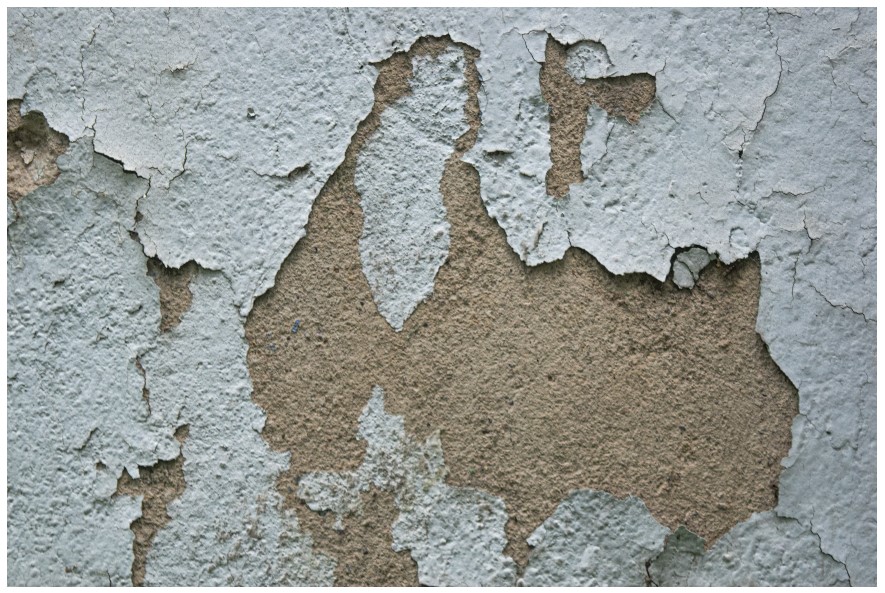Water damage isn’t just a hassle; it can secretly harm your home’s structure and your family’s health. While it can strike anywhere, the ceiling is one of the most noticeable and concerning areas. Eliminate outdated tiles and improve room acoustics by scheduling our safe acoustic ceiling removal today.
In this blog, we’ll delve into the importance of addressing water-damaged ceilings and discuss the various signs that can alert you to the presence of this issue. Understanding these signs is crucial for early detection and timely intervention.
Signs of Water Damage on Ceilings

Watermarks or Brown Rusty Stains
Watermarks and brown, rusty stains on your ceiling indicate water damage. They often appear as discolored patches and are the most visible signs of a problem.
Bubbling or Blistering Paint on Walls
Water damage can impact not only the ceiling but also adjacent walls. If you notice paint on your walls bubbling, blistering, or peeling, it may be due to water seeping through.
Sagging Ceilings or Walls
Severe water damage can lead to ceilings or walls sagging under the weight of absorbed water. A sagging ceiling is a serious concern and requires immediate attention.
Stained or Warped Wood
In addition to the ceiling, water damage can affect wooden elements in your home. Look for discolored or warped wooden beams, joists, or structural components, as these are signs of water infiltration.
Cracked or Discolored Tiles
In bathrooms or kitchens, water damage can affect tiles. Look for cracked or discolored tiles, which could be due to water infiltrating the underlying materials.
Warping or Buckling of Flooring
Water can seep through the subfloor, causing the flooring above to warp, buckle, or become discolored. These changes in your flooring may indicate underlying water damage.
Mold Along Corners, Ceilings, and Walls
Mold thrives in damp environments, and a water-damaged ceiling provides the ideal conditions for its growth. Mold can manifest as dark spots or fuzzy patches along the ceiling, corners, and adjacent walls.
Swollen Ceilings
When exposed to water, ceiling materials, such as drywall or plaster, can absorb moisture and swell. A swollen or bulging ceiling is a definite sign of water infiltration.
Wallpaper, Baseboards, Trim Separating from Walls
Water damage can weaken the adhesive holding wallpaper, baseboards, and trim in place. If you notice these elements separating from the walls, it indicates water issues.
Sweating Walls
Moisture accumulating on your walls, causing them to appear sweaty or wet, is a strong sign of water damage. This can be due to leaks or excessive humidity.
Peeling Paint
Water can cause the paint on your ceiling to bubble or peel. If you see paint flaking off, it’s likely due to underlying water damage.
Cracks or Bubbles
Water-damaged ceilings often develop cracks or bubbles in the paint or plaster. These irregularities are a result of the ceiling material’s interaction with moisture.
Musty Smell
An unpleasant, musty odor is often a sign of mold growth, resulting from water damage. If you detect this odor in your home, it’s time to investigate further.
What to Do if There’s Water Damage on Your Ceiling
Discovering water damage on your ceiling can be a distressing experience, but taking immediate action is crucial to prevent further harm and costly repairs.
Here’s a step-by-step guide on what to do if you encounter water damage on your ceiling:
1. Find the Source of the Leak
The first and most critical step is to identify the source of the leak. It could be a leaky roof, a burst pipe, a damaged water heater, or condensation. Addressing the root cause is essential to prevent ongoing damage.
2. Stabilize the Leak
While you work on fixing the source of the leak, it’s essential to prevent more water from entering your ceiling. Place buckets or containers under the leak to catch any dripping water. You can also use towels or cloths to absorb excess moisture.
3. Fix the Source of the Leak
Once you’ve identified the cause of the leak, repair it or call a professional to do so. If the issue is related to your plumbing, it’s a good idea to turn off the water supply to the affected area until it’s fixed to prevent further damage.
4. Remove Damaged Materials
Carefully remove any damaged ceiling materials, such as wet drywall or insulation. Use caution during this step to avoid injury or further damage. It’s essential to discard these materials to prevent mold growth.
5. Let the Drywall Completely Dry
Allow the exposed ceiling and any remaining materials to dry thoroughly. This can take some time, and it’s important not to rush this process. Adequate drying is essential to prevent mold growth and ensure the new materials adhere properly.
6. Repair the Ceiling
Once the area is completely dry, you can begin the repair process. You may need to replace the removed materials, depending on the extent of the damage. This can involve patching, priming, and painting to restore the ceiling’s appearance. If the damage is extensive, consider consulting a professional for the repairs.
7. Prevent Future Damage
To avoid future water damage, consider taking preventive measures. Frequently check your home for possible sources of leaks or water getting in. Ensure proper roof, plumbing, and insulation maintenance to minimize the risk of future ceiling damage.
8. Document the Damage
Documenting the damage with photographs can be beneficial, as this may be needed for insurance claims or future reference.
9. Professional Assistance
If in doubt or if the damage is extensive, don’t hesitate to seek professional assistance. Professionals have the expertise and tools to address water damage effectively and ensure it doesn’t reoccur.
10. Inspect Electrical Components
In cases of severe water damage, inspect the electrical components in the affected area. If there is any doubt about the safety of the wiring, turn off the power to that section to prevent electrical hazards.
11. Preventive Measures
Once the damage is repaired, take measures to prevent future water damage. This may include regular roof inspections, fixing plumbing issues, and ensuring your home is well-insulated and protected against leaks.
12. Routine Maintenance
Regularly maintain your home’s components, such as the roof, gutters, and plumbing. Preventative maintenance can go a long way in averting water damage issues.
Hire a Professional
While it might be tempting to tackle the issue yourself, there are compelling reasons to consider the services of a professional. Here’s why you should choose a professional for this critical task:
1. Expertise and Knowledge
Professionals are well-versed in repairing water-damaged ceilings. They possess the necessary expertise and knowledge to identify the extent of the damage, understand the underlying causes, and employ effective repair techniques. Their skills ensure a thorough and lasting solution.
2. Quick Service
Time is of the essence when it comes to water damage. Professionals can provide swift service, addressing the issue promptly to prevent further damage. Their experience enables them to work efficiently without compromising on quality.
3. Save Time
Repairing water-damaged ceilings can be a complex and time-consuming endeavor. Professionals are equipped with the tools, materials, and techniques to streamline the process. Hiring experts saves valuable time, which you can use to focus on other chores.
4. Professional Advice
Beyond repairs, professionals can offer invaluable advice on preventing future water damage. They can assess the vulnerability of your space, recommend preventive measures, and guide you on maintenance practices to safeguard your ceilings from future issues.
5. Comprehensive Service
Professionals don’t just fix the visible damage; they also address potential hidden issues. They can identify mold growth, structural damage, and other related problems.
6. Safety and Health
Water damage can pose safety and health risks, especially if mold is involved. Professionals are well-equipped to handle these risks, ensuring a safe and healthy environment for you and your family.
7. Quality Assurance
Hiring a professional assures you of quality workmanship. Their experience and adherence to industry standards result in repairs that stand the test of time. You can rest easy knowing that the issue has been resolved effectively.
Conclusion
Water damage can be a daunting and urgent issue, but the decision to hire a professional for repairs is a choice that brings numerous advantages. As we reflect on the key points, it’s clear that professionals offer expertise, quick service, time-saving solutions, and much more. When water damage threatens your ceilings, a professional is your ally in safeguarding your home.
Feel free to seek Custom Painting, Inc.’s professional assistance to address the issue promptly and effectively. Your home’s well-being and your family’s safety depend on it. Call us today at 925-294-8062 or fill out this contact form, and one of our representatives will call you soon. Serving the Bay area including the cities of San Jose, San Ramon, Santa Clara, Sunnyvale and Sunol.




